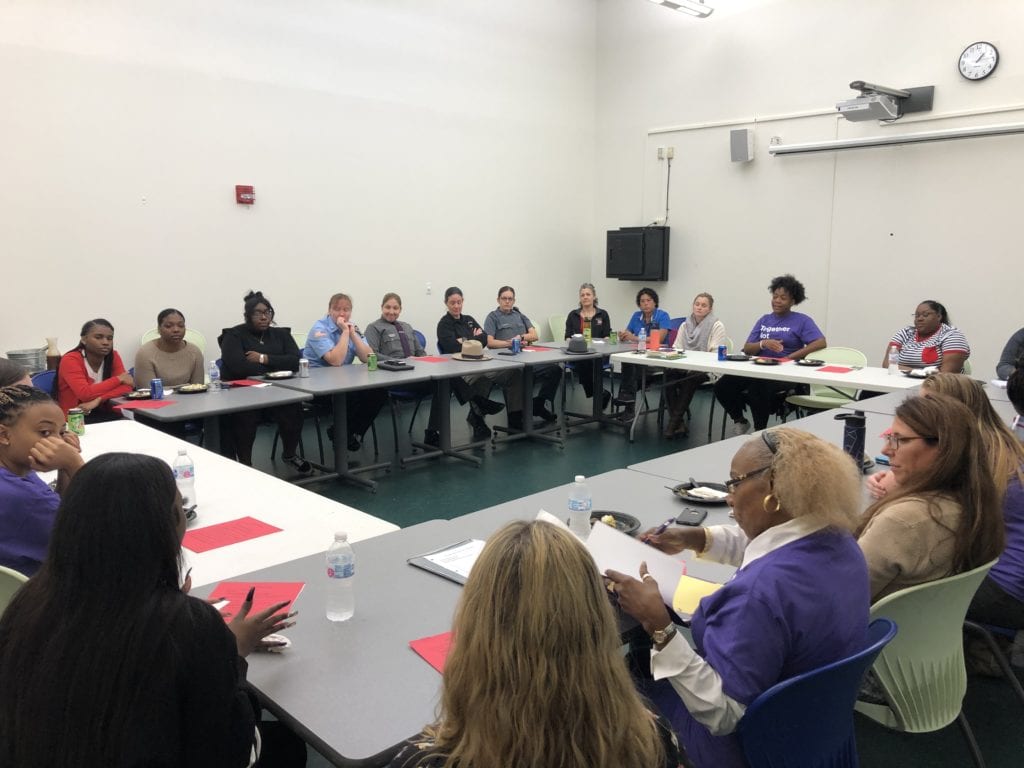
Law enforcement isn’t just about handcuffs or foot chases, although sometimes those are required in less than ideal situations.
What it’s really about, explained Investigator Marie Finelli of SUNY Broome’s Office of Public Safety, is conflict resolution. And the best way to resolve conflicts is to begin a conversation – one that recognizes the participants’ worth and agency, and seeks to achieve mutual understanding.
Enter the Lunch with the Law program, which brings law enforcement together with students of color to answer questions and find common ground. The program began with SUNY Broome’s Men of Excellence program, and has now expanded into a separate event for women – the women of law enforcement, and both SUNY Broome and Union-Endicott High School students.
The Oct. 22 event was organized by SUNY Broome’s PEP Squad – short for Phenomenal, Educated and Powerful – and included both Union-Endicott High School’s TNT student group and seven women in law enforcement professions.
A group for SUNY Broome women of color, the PEP Squad chose law enforcement because of the popularity of criminal justice majors among students, explained event coordinator Amber Gary, a second-year Liberal Arts major. Health fields are another interest, and will be the focus of a future event. The day also marked the start of a mentoring relationship between the PEP Squad and TNT, short for “together, not torn.”
During Lunch with the Law, the students learned about law enforcement careers and also shared thoughtful reflections on both policing and community issues, ranging from the impact of social media to overcoming distrust.
“Today is an opportunity to gather together, network and ask questions about future careers,” Gary said. “We want everyone to feel open enough to ask questions. We want to learn from your experience.”

Voices from the field
Participating professionals included Angel Johnson from the New York State Department of Corrections, New York State Trooper Lauren Warner, Chantal Brutovsky from Broome County Probation and SUNY Broome alumna Angelica Stanko, now an officer with Binghamton University Police.
Representing SUNY Broome were Finelli with the college’s Office of Public Safety – also a part-time police officer in Owego and a college alumna – and Criminal Justice Professors Leigh Martindale and Kerry Weber. Before transitioning to teaching, Martindale worked in juvenile justice for the New York State Division of Criminal Justice Services and for the Broome County Public Defender; Weber spent 11 years as a patrolwoman in Southern California.
The professionals took various routes to their careers – some of them unexpected. While Johnson came from a law enforcement family, she was also out on her own at the age of 16, which forced her to grow up quickly. When she began in corrections, she was among only five women; now, she has 50 female colleagues.
“Whatever door opened for me, I went through it,” she said. “Sometimes in law enforcement, it’s tough for women, especially in corrections.”
Warner, the state trooper, was encouraged to go into a more traditionally feminine career during her college days: teaching. She worked as a teacher for 11 years when, as a mother of three, she decided to follow her interests in law enforcement. Her school was supportive, and gave her a leave of absence while she tested out her new career.
“I went through the academy, which was a challenge, but once I got on the road, I enjoyed what I was doing,” she said.
Jobs weren’t immediately available when Stanko, the SUNY Broome alumna, initially graduated, and she ended up earning her master’s degree during the course of her career. Martindale had earned her initial degree in Spanish and originally considered becoming an attorney.
Finelli’s trajectory was decidedly non-traditional. One of five children, she grew up poor, and lost her father at the age of 12. She had a child herself at the age of 15, earned her GED and worked a series of jobs, from fast-food to hospitality security guard. Ultimately, she paid her own way through the academy and was hired by SUNY Broome – close to her original goal of becoming a school resource officer.
For Finelli, the toughest part was developing the confidence to succeed – to change her mindset and tackle her goals one piece at a time. “It’s a mental game,” she told students.
When she worked patrol, Weber found the physical preparations to be the toughest part. She needed to pass an obstacle course that mirrored a foot chase – complete with a 150-pound dummy drag and a 6-foot-tall chain link fence she needed to scale. These aren’t arbitrary tasks, either; they mimic actual feats that law enforcement officers perform in the field.
“It took me nine months of working out every day and climbing over wall after wall after wall. I’m a small female, but I can do this,” she said.

Weighing choices
Anecdotally, Brutovsky has seen more female offenders enter the criminal justice system, although the reasons for that are multifaceted. Family breakdown, dysfunctional romantic relationships and a more disconnected society can all play a part, as well as social media platforms that disseminate incorrect or outdated information – and outrage.
Communities of color are often wary of law enforcement, feeling prejudice and dislike, reflected one PEP Squad member, who volunteers with an anti-gun violence group in Harlem. These feelings can be exacerbated by national incidents involving the deaths of people of color who come into contact with law enforcement.
But people may not realize that law enforcement officers can feel the same pressures. When she’s wearing her uniform, Finelli has sometimes perceived people immediately disliking and distrusting her, she related. Stigma, as it turns out, can go both ways.
Both students and professionals alike discussed ways to address these issues. Many are sociological and wide-ranging, from the way communities set up policing initiatives to our choices on social media. On the probation and parole side, there is a trend toward more therapeutic treatment of offenders rather than punitive action, Brutovsky noted.
But personal choices play a role, too. As a teen, Amanda remembered feeling the need to immediately react when affronted or wronged. As she gained more life experience, she learned how to control her emotional response – and thus the situation.
“Sometimes as people we take these lessons for granted,” she reflected. “Someone is always going to do something to see how far they can push your buttons.”

